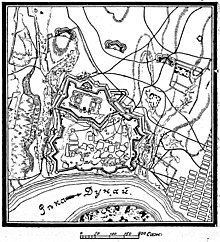
Back هجوم حصن إسماعيل Arabic İzmailin mühasirəsi Azerbaijani Щурм на Измаил Bulgarian Belagerung von Ismail German Πολιορκία του Ισμαηλίου (1790) Greek Bataille d'Izmaïl French כיבוש איזמאיל HE Assedio di Izmaïl Italian Beleg van Izmajil Dutch Zdobycie twierdzy Izmaił Polish
| Storming of Izmail | |||||||
|---|---|---|---|---|---|---|---|
| Part of Russo-Turkish War (1787–1792) | |||||||
 The capture of Izmail by Russian troops under the command of General-in-Chief A. V. Suvorov on 11 December 1791, Mikhail Ivanov | |||||||
| |||||||
| Belligerents | |||||||
| Commanders and leaders | |||||||
|
|
| ||||||
| Units involved | |||||||
|
| |||||||
| Strength | |||||||
|
28,000–32,000[g] 500[7] to 600[1] guns |
40,000–42,000[h] 265 guns[10][7] | ||||||
| Casualties and losses | |||||||
| 4,582 to 10,000 killed & wounded[i] |
Total: 40,000 casualties all artillery pieces[8][10]up to 400 standards[10] | ||||||


The siege of Izmail or Ismail / Ishmael / İzmail (Turkish: İzmail Kuşatması), also called the storming of Izmail[8] (Russian: Штурм Измаила), was a military action fought in 1790 on the Black Sea during the Russo-Turkish War (1787–1792) and simultaneously the Austro-Turkish War (1788–91). The Russians were led by Alexander Suvorov, who had defeated the Ottomans at Kinburn, Focsani, and Rymnik, as well as participating in the siege of Ochakov. The Black Sea rowing flotilla was commanded by the Spanish admiral José de Ribas (Iosif Deribas). It is regarded as one of Suvorov's finest victories and one of the greatest deeds in world military history.[16]
The fortress was considered to be impregnable and was referred to as "a fortress without weak points",[17] and was commanded by one of the best and most experienced Ottoman generals, Aydoslu Mehmed Pasha.[18][19]
Cite error: There are <ref group=lower-alpha> tags or {{efn}} templates on this page, but the references will not show without a {{reflist|group=lower-alpha}} template or {{notelist}} template (see the help page).
- ^ a b c d Velichko et al. 1912, pp. 572–577.
- ^ Orlov 1890, pp. 51–53.
- ^ Skritsky 2002, pp. 367–369.
- ^ Skritsky 2002, pp. 369–370.
- ^ a b c d e Petrushevsky, Alexander (1884). Generalissimo Prince Suvorov (in Russian). Vol. 1 (1st ed.). St. Petersburg: Типография М. М. Стасюлевича. pp. 383–384.
- ^ a b c d e Duffy C. Russia's Military Way to the West: Origins and Nature of Russian Military Power 1700–1800. Routledge & Kegan Paul Books Ltd. 1985. p. 188
- ^ a b c d Kolganov 2016.
- ^ a b c d e f g h Bodart 1908, p. 267.
- ^ a b Orlov 1890, p. 52.
- ^ a b c d e f g h i Arsenyev & Petrushevsky 1894, pp. 849–851.
- ^ a b Grant 2017, p. 478.
- ^ a b Valery Pоsternak. Ismail Gechidi. – Kharkiv, 2015. – p. 146.
- ^ a b Longworth 1966.
- ^ a b c Orlov 1890, p. 81.
- ^ a b Orlov 1890, p. 80.
- ^ Osipov, K. (1939). Alexander Suvorov: A Biography. Hutchinson & Co. p. 91.
- ^ "24 декабря – День воинской славы России: День взятия турецкой крепости Измаил - Российское историческое общество". historyrussia.org (in Russian). 24 December 2023. Retrieved 18 April 2024.
- ^ Osipov, K. (1939). Alexander Suvorov: A Biography. Hutchinson & Co. p. 86.
- ^ "Russian armies captured a Turkish fortress Izmail". Presidential Library. Retrieved 27 April 2024.
© MMXXIII Rich X Search. We shall prevail. All rights reserved. Rich X Search